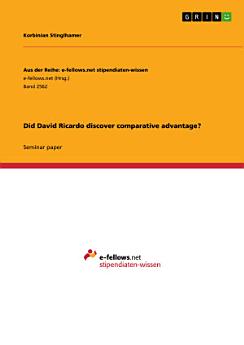Did David Ricardo discover comparative advantage?
Oct 2017 · Aus der Reihe: e-fellows.net stipendiaten-wissen Book 2562 · GRIN Verlag
Ebook
10
Pages
family_home
Eligible
info
reportRatings and reviews aren’t verified Learn More
About this ebook
Seminar paper from the year 2016 in the subject Economics - Foreign Trade Theory, Trade Policy, grade: 1,0, University of Wisconsin-Madison (Economics), course: Economics 305/History of Science 305: Development of Economic Thought, language: English, abstract: This paper examines if the law of comparative advantage really was discovered by David Ricardo. It investigates the arguments against and for David Ricardo’s discovery made by three modern authors, Thweatt (1976), Ruffin (2002), and Gehrke (2015). It analyzes and evaluates the argumentation made by these authors in order to identify the most compelling interpretation of Ricardo’s discovery. Thweatt argues that Ricardo’s writing about comparative advantage was probably not his own. Thweatt claims that Ricardo probably took the concept of comparative advantage from Mill. In contrast, Ruffin states that there is evidence that Ricardo very well discovered comparative advantage on his own. Ruffin’s key evidence for this argumentation are three letters, which should indicate that Ricardo worked out comparative advantage during October 1816. Finally, Gehrke claims that Ruffin’s interpretation of the three letters is not solid. According to Gehrke, there is no evidence that Ricardo really worked out comparative advantage.
Rate this ebook
Tell us what you think.
Reading information
Smartphones and tablets
Install the Google Play Books app for Android and iPad/iPhone. It syncs automatically with your account and allows you to read online or offline wherever you are.
Laptops and computers
You can listen to audiobooks purchased on Google Play using your computer's web browser.
eReaders and other devices
To read on e-ink devices like Kobo eReaders, you'll need to download a file and transfer it to your device. Follow the detailed Help Center instructions to transfer the files to supported eReaders.







